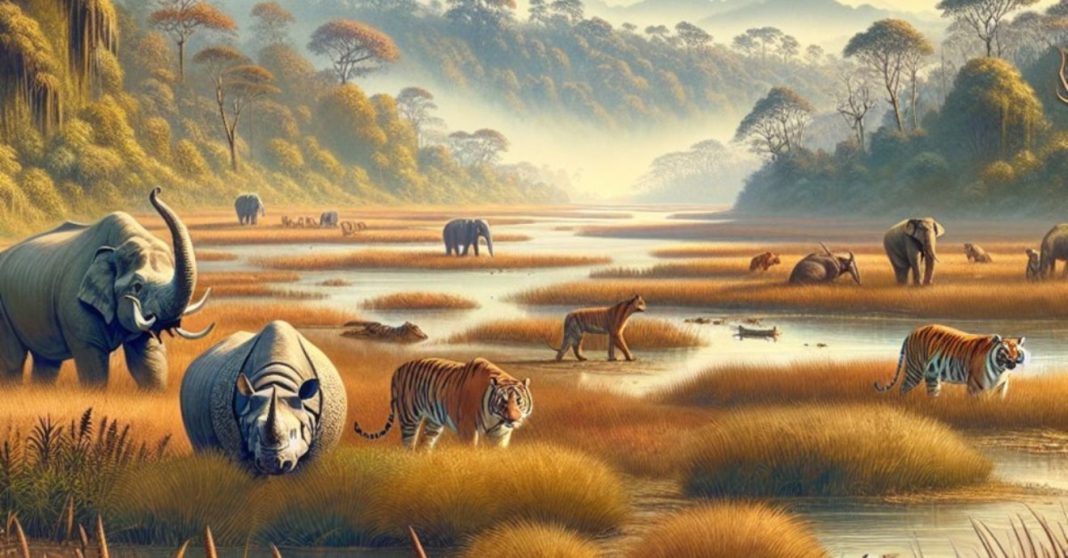The Kaziranga Biodiversity Crisis is one of the most alarming environmental challenges India faces today. Kaziranga National Park in Assam is not just a forest — it is a living treasure that protects some of the rarest species on Earth, including the world-famous one-horned rhinoceros. However, in recent years, this natural wonder has been facing multiple threats that endanger its delicate balance of life.
What Do We Mean by Kaziranga Biodiversity Crisis?
The Kaziranga Biodiversity Crisis refers to the growing problems that harm the plants, animals, wetlands, and forests of Kaziranga National Park. Biodiversity means the variety of all living beings — from big animals like rhinos and tigers to small insects, fishes, and even grasses. When this balance is disturbed, the entire ecosystem is in danger.
In Kaziranga, biodiversity is under attack due to floods, human interference, climate change, poaching, and road accidents. Without urgent action, many species could face extinction.
Why Kaziranga’s Biodiversity is So Important
Kaziranga as the Home of the One-Horned Rhinoceros
Kaziranga is the only safe home for over 2,400 one-horned rhinoceroses — nearly 70% of the world’s population. If the Kaziranga Biodiversity Crisis is not controlled, this iconic animal could become endangered again.
A Stronghold for Tigers and Elephants
Kaziranga has the highest density of tigers in the world. Along with elephants and swamp deer, they form the backbone of the park’s ecosystem. Protecting them ensures that the entire food chain remains balanced.
Bird Paradise of Asia
The park is a heaven for over 450 species of birds, including migratory birds like storks, geese, pelicans, and cranes that travel thousands of kilometers to reach Kaziranga every year.
Natural Flood Buffer and Climate Controller
Kaziranga’s wetlands act like giant sponges, absorbing floodwaters from the Brahmaputra River and reducing flood damage in nearby villages. Its forests also absorb carbon dioxide, helping slow down climate change.
Major Causes of the Kaziranga Biodiversity Crisis
Floods in Kaziranga National Park
Seasonal floods in the Brahmaputra River are natural, but climate change has made them more frequent and severe. During these floods, animals like deer, rhinos, and tigers move to higher grounds, but many get trapped and die. In 2020, for example, more than 200 animals perished.
Encroachment and Loss of Forest Cover
Villages expanding near the park cut down trees and destroy grasslands for farming and settlements. This reduces the natural habitat, forcing animals into smaller spaces and increasing human-wildlife conflict.
Poaching and Illegal Wildlife Trade
Poaching of rhinos for their horns remains a huge concern in the Kaziranga Biodiversity Crisis. Despite strong laws, poachers target rhinos because their horns fetch high prices in the illegal market.
Road and Railway Threats
The National Highway and new railway tracks near Kaziranga have turned into death traps. When animals cross during floods, speeding vehicles often hit them.
Climate Change and Global Warming
Rising temperatures, irregular monsoons, and shrinking wetlands are disturbing the natural cycles of breeding and food availability for Kaziranga’s wildlife.
Human-Wildlife Conflict
As forests shrink, animals often enter nearby villages searching for food. Elephants damage crops, rhinos enter paddy fields, and tigers sometimes attack livestock, creating fear and anger among locals.
Impact of the Kaziranga Biodiversity Crisis
On Animals and Birds
- Sharp decline in the population of swamp deer and wild buffalo.
- High death rates of rhinos and deer during floods.
- Migratory birds losing wetlands to rest and feed.
On Local People
- Farmers suffer huge losses when elephants and rhinos raid their crops.
- Eco-tourism, which supports many families, will decline if wildlife disappears.
- Frequent floods without Kaziranga’s natural forest cover will destroy homes and farmlands.
On the Environment
- Breaking of the food chain and ecological balance.
- More soil erosion due to reduced forest cover.
- Drying wetlands leading to less groundwater and poor water quality.
Solutions to the Kaziranga Biodiversity Crisis
Building Animal Corridors
Special corridors and underpasses should be built along highways so that animals can safely cross during floods without getting killed by vehicles.
Artificial Highlands for Flood Protection
Highlands or elevated areas inside the park give animals shelter when floodwaters rise, saving hundreds of lives.
Strong Anti-Poaching Units
Using drones, night vision cameras, and well-armed guards can completely stop poaching and protect the one-horned rhinoceros.
Community-Based Eco-Tourism
Villagers near Kaziranga should be encouraged to take part in eco-tourism. This will give them jobs while ensuring they protect, not harm, the park.
Afforestation and Wetland Restoration
Planting more trees and cleaning wetlands will restore natural habitats for birds and animals.
Climate Action at Local and Global Level
Reducing pollution, switching to renewable energy, and protecting forests can slow down the impacts of climate change on Kaziranga.
Government and Global Role in Solving the Kaziranga Biodiversity Crisis
- Government of Assam has increased the number of guards and set up new patrol camps.
- Kaziranga Tiger Reserve Authority monitors wildlife using camera traps and drones.
- UNESCO and WWF are helping with funds and expertise to save endangered species.
- Global conservation networks spread awareness to the world about the Kaziranga Biodiversity Crisis.
How Students and Citizens Can Help Kaziranga
Even children and common citizens can play a part:
- Organize awareness campaigns on the Kaziranga Biodiversity Crisis.
- Reduce plastic use as it pollutes wetlands and kills animals.
- Volunteer for plantation drives in Assam.
- Support eco-friendly tourism whenever visiting Kaziranga.
- Share knowledge about wildlife protection with friends and family.
Conclusion
The Kaziranga Biodiversity Crisis is not just Assam’s problem — it is a global warning. If we lose Kaziranga’s biodiversity, the world will lose a priceless heritage of nature. Protecting Kaziranga means saving the one-horned rhinoceros, the tigers, the elephants, and thousands of birds and plants that keep our environment alive. Together, with urgent action, we can turn this crisis into a story of hope and survival.




